SEO Marketing for Small Businesses: Is it Worth it?

.”SEO is dead”.
“SEO is dying”.
“SEO isn’t worth the stress and headache”.
You’ve probably heard these phrases a thousand times and over.
And I get it. You’ve got some solid reasons to eat them up.
After all, you’ve tried everything, published content after content.
Yet, your traffic is flat. Leads aren’t coming in.
And worst of all? Google keeps changing the rules.
Now you feel like “Is SEO even worth it for small businesses”.
You’re not alone. In my five years as an SEO strategist and copywriter, I’ve met many small business owners and entrepreneurs who felt exactly the same way.
And I still do.
But before you call it a quit on SEO, look at these:
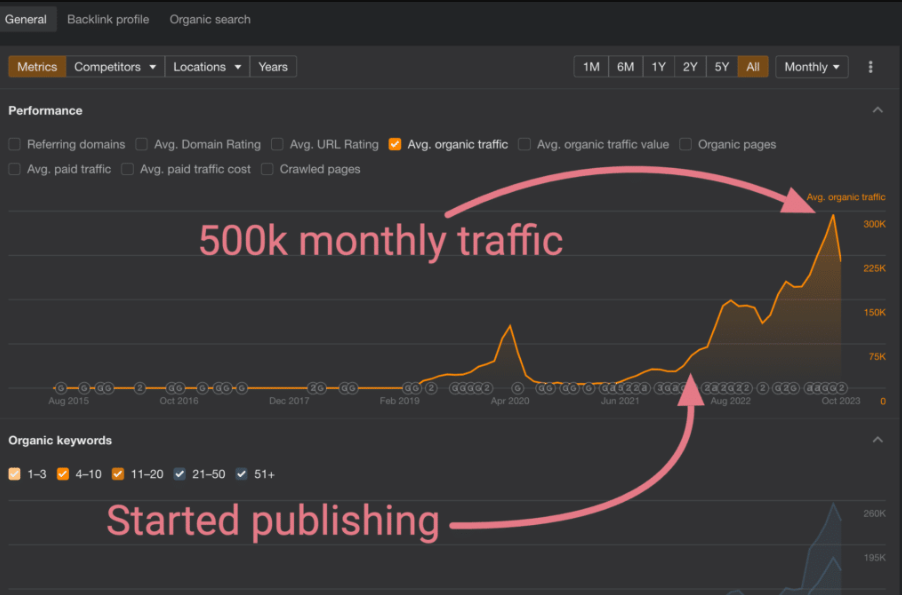
And then this:
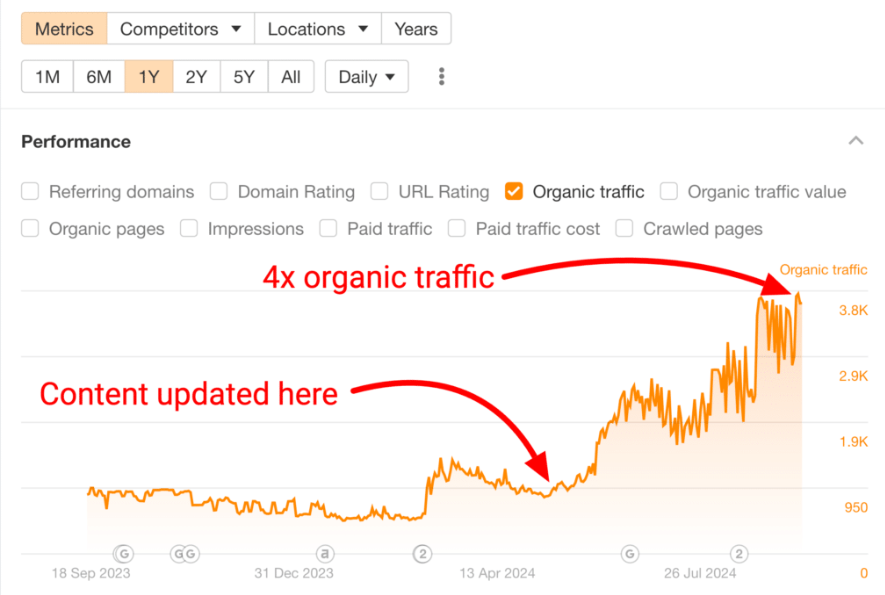
These are small business websites winning big with SEO marketing.
The question now is, why do these businesses get thousands of leads monthly while you barely crack 50 organic visits in three?
I’ll help you with the answer.
In this article:
- SEO Marketing Isn’t Working for Your Small Businesses?
- Is SEO Worth It for Small Businesses?
- The Current State of SEO Marketing in 2025
- Businesses Still Win with AI Search Engines
- SEO vs. Social Media: Which One Drives More Business?
- Why Small Businesses Struggle with SEO Marketing
- Use E-E-A-T to Improve Your SEO Marketing
- Expertise – Are you a subject matter expert?
- Better SEO Marketing for Your Small Business
SEO Marketing Isn’t Working for Your Small Businesses?
The majority of small businesses approach SEO in a completely wrong way.
Here’s a far-too-common scenario I’ve seen played out when new founders start their SEO marketing journey:
- Hire a self-acclaimed SEO writer on Fiverr or Upwork
- Give them topics off your head. No research. No keyword. No strategy.
- Pay them to write 2X 1000-word blog post weekly
- Copy directly from Google Docs, paste into WordPress, and hit the Publish button.
- Rinse and repeat.
This approach is what I call the “Publish and Hope” strategy.
Don’t get it twisted. I’m not against hiring freelance writers on those platforms.
I only pick a bone with website owners when they do so without a content strategy.
And from experience, I’ve seen many new entrepreneurs embrace this vicious cycle due to their perceived budget constraints.
It’s understandable. But here’s the truth
You don’t have to spend thousands of dollars monthly on SEO marketing to start seeing meaningful results.
Your budget constraint isn’t an excuse for choosing the wrong SEO approach.
Come to think of it;
- You’ve been doing content for months or even years without an SEO content strategy.
- For far too long, you’ve been publishing blog posts with bad on-page formatting.
- You’ve never performed an SEO audit of your site.
- You’ve got hundreds of posts on your website with no traffic to show for it.
These, amidst other issues we’ll touch on in this guide, are why SEO marketing isn’t working for you, not budget constraints.
The truth is, that you can achieve substantial SEO growth by working with the right people.
Now back to your question.
Is SEO Worth It for Small Businesses?
I won’t tell you a straight-up Yes or No, for 2 reasons:
- A lot is changing in the SEO world, and fast.
- And as an SEO marketer, my opinion will be biased.
Instead, I’ll let the data do.
So, let’s go find out:
✅ Whether SEO still works for small businesses with limited budgets and resources in 2025 (or if ads and social media should be your priority).
✅ Why some businesses see massive SEO success while others struggle.
✅ And finally: Should you invest in SEO, or is it time to move on?
The Current State of SEO Marketing in 2025
SEO has evolved from ranking pages to building brand authority across multiple platforms.
The emergence of AI search engines like ChatGPT search, Perplexity AI, and Google AIOs is forcing marketers to rethink their SEO approaches.
Businesses must also adapt to changing searchers’ behavior to remain competitive in today’s search market.
I discussed these changes extensively in my 2025 SEO trends reports.
However, despite these new trends, the basics of SEO remain the same.
Whether someone is looking for a nearby restaurant, a reliable handyman, or a specific product, they’re likely to start on Google.
As of February 2025, almost 70% (5.56 billion people) of the world’s population are Internet users, and over 93% of their online experience begins with a search engine.
No wonder more than 8.5 billion Google searches are made every day.
That’s a lot of potential customers if your business shows up in those searches.
Those are for starters. Let’s compare SEO marketing to other digital marketing channels.
| Marketing Channel | Cost | Speed | Long-Term ROI | Best For |
| SEO | $$ | Slow | ⭐⭐⭐⭐ | Sustainable growth, brand authority |
| PPC | $$$$ | Fast | ⭐⭐ | Immediate leads, short-term campaigns |
| Social Media | $$ | Medium | ⭐⭐ | Brand awareness, audience engagement |
| Local Ads | $$$$ | Fast | ⭐ | Traditional reach, expensive per lead |
Organic Search Is Still the Top Traffic Source for All Websites
The growing popularity of social media and paid advertising has made many small business owners assume that organic search now has little to no business impact.
The reality, however, is quite the opposite.
Despite the buzz around Facebook ads, Instagram influencers, and TikTok virality, organic search remains the biggest driver of website traffic.
And that’s by a significant margin.
A study by BrightEdge found that organic search accounts for 53% of all website traffic, dwarfing paid search at 15% and social media at just 5%.
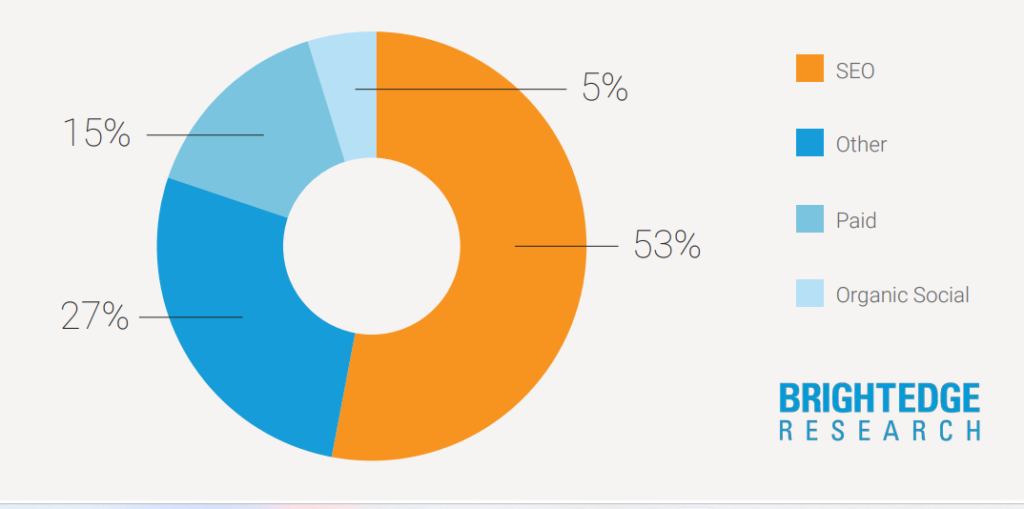
This means that more than half of your potential customers are finding businesses like yours through search engines.
It’s undeniable that PPC may deliver faster results.
However, in the long run, companies with active blogs generate an average of 67% more leads than those without.
So if you neglect SEO for paid ads or social media campaigns, you risk missing out on your most valuable, high-intent traffic source.
SEO-Generated Leads Convert Better
Not only does SEO marketing drive traffic. It also brings in higher-quality leads. Why?
Users who find your business through searches are actively seeking solutions to their problems.
As such, you’ve got less selling to do, which gives you a better chance of converting them.
A potential customer searching for the “best chiropractor near me” or “how to relieve back pain” is much closer to purchasing someone casually watching videos on Instagram.
People scrolling through social media are often in passive browsing mode. They randomly bump into your content while scrolling.
A study by First Page Sage (2024) found that SEO-generated leads have a 14.6% close rate, compared to only 1.7% for outbound marketing methods.
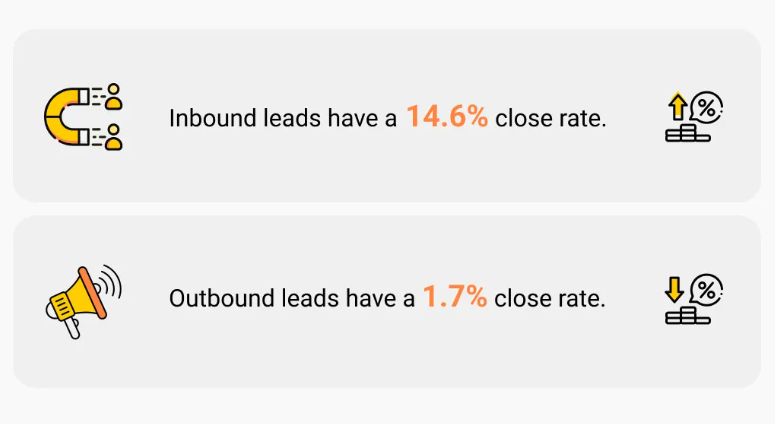
That’s why businesses that invest in SEO tend to see better long-term returns than those relying solely on paid ads or other aggressive sales tactics.
60% of marketers note that inbound marketing strategies like SEO and blog content bring higher-quality leads. (Statista).
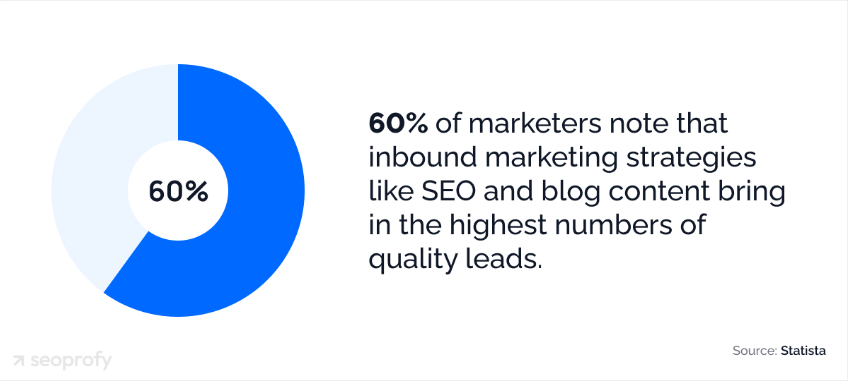
Again, this means customers who find you through organic search are more likely to convert into paying clients.
Businesses Still Win with AI Search Engines
One of the reasons people anticipate the demise of SEO is the rise of Google’s Search Generative Experience (SGE) and similar AI-powered search engines like Perplexity AI and SearchGPT.
After all, if AI-generated answers appear at the top of search results, will users even click through to websites?
The short answer is yes, but only if your business adapts to this new reality.
A new study shows that AI Overviews appear in 47% of searches.
That means users now interact with AI-generated summaries before clicking on a website.
While this might seem like a threat, it’s also an opportunity.
If your content is cited in these summaries, it builds trust and visibility, even if users don’t click through immediately.
Organic click-through rates (CTR) have indeed declined due to AI Overviews.
However, this decline is offset by the increased importance of being featured in AI-generated answers.
AI search engines source their information from websites. And they prioritize authoritative, trustworthy content.
In Botify’s 2024 AIO report, 75% of websites cited in AI Overviews come from the top 12 organic rankings.
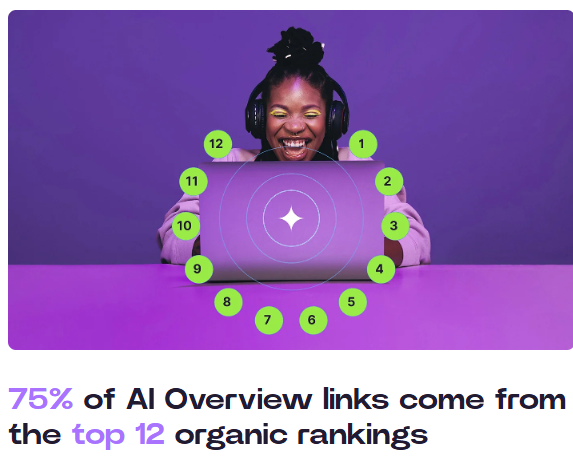
So if your website ranks well on traditional search engines, it’s more likely to be featured in AI-generated summaries.
The story is the same with LLM-powered search engines.
Several studies show that ranking high on Google strongly correlates with being cited by AI search results, as these systems rely on the same signals of authority.
Let’s perform a simple experiment to verify that using 2 traditional search engines (Google and Bing) and 2 AI search engines (Perplexity AI and ChatGPT search).
For this experiment, I’ll assume I’m a small business owner.
I’ve learned the importance of SEO but now, I want to know the different types of SEO.
I’ll type this query into Google“Types of SEO”
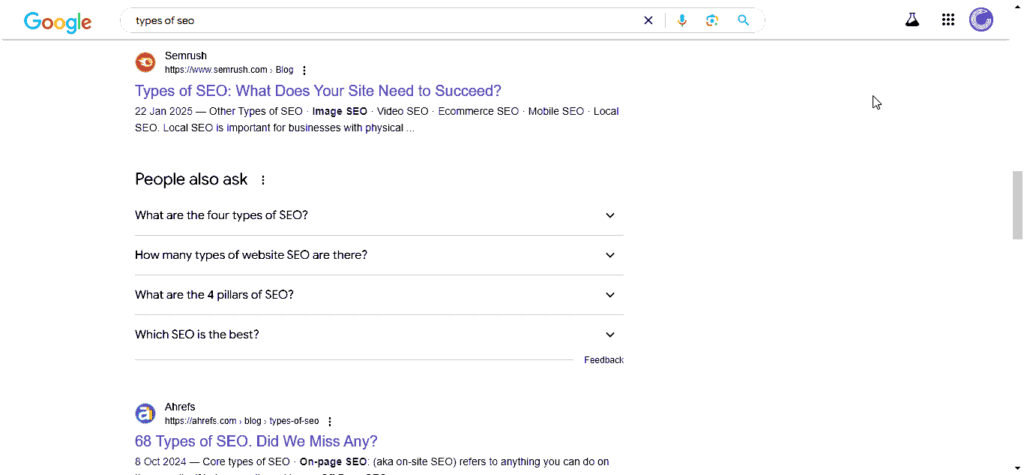
I’ll repeat the same query on Bing, then on Perplexity AI and ChatGPT search.
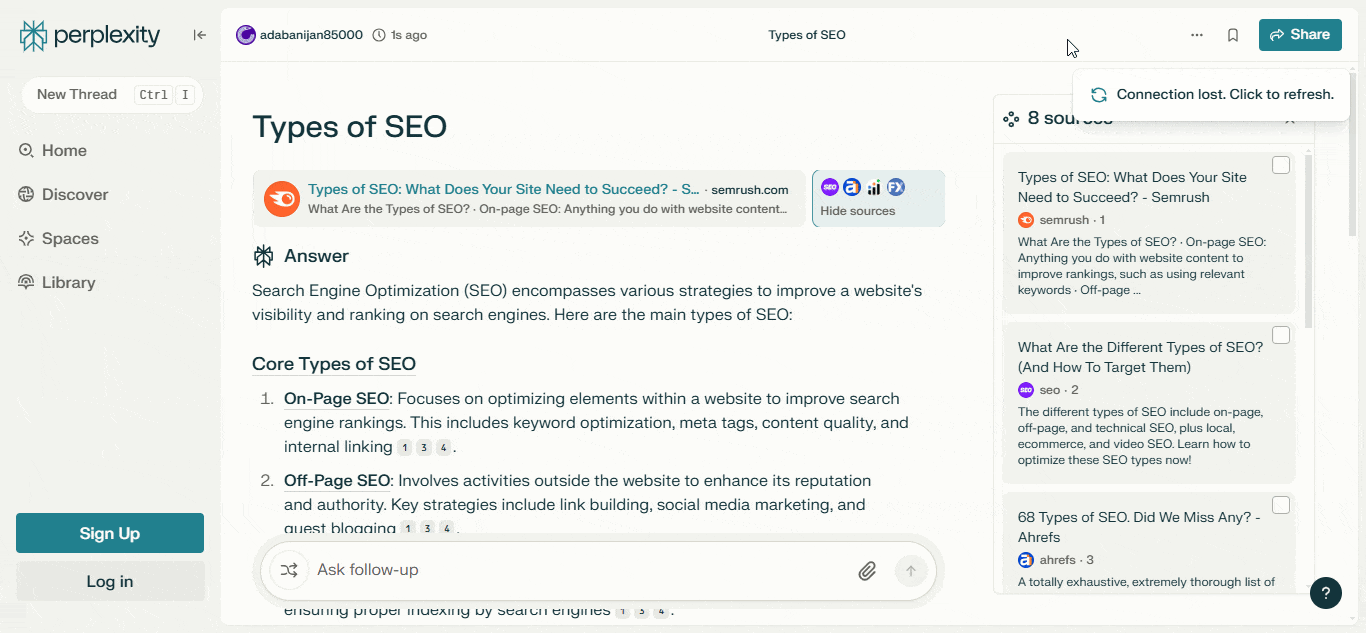
Here are the results as compared to the top 10 on Google SERPs:
- Perplexity AI citations overlap with the top 10 SERP rankings by 50%.
- 70% of websites in the top 10 Google organic ranking also appear in ChatGPT search result citations.
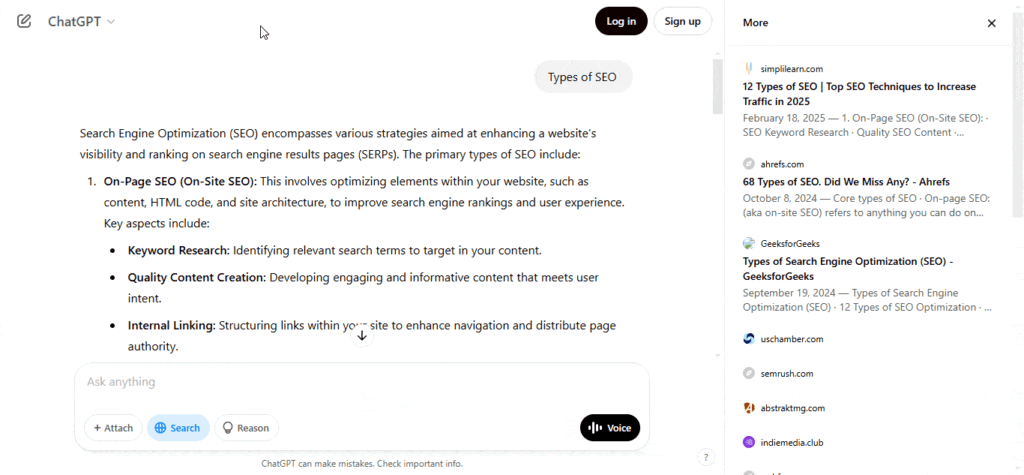
The result as compared to Bing search results:
- 5 out of the top 10 websites on Bing SERP are present in ChatGPT search citations.
- Perplexity AI link card matches Bing SERP by 40%
From my mini experiment, it’s evident that AI-powered searches won’t kill SEO.
It will only change how we approach it.
Senior Vice President of Enterprise Solutions for Semrush, Marcus Tober studied the relationship between LLM citations and traditional search results.
His findings further established a similar fact:
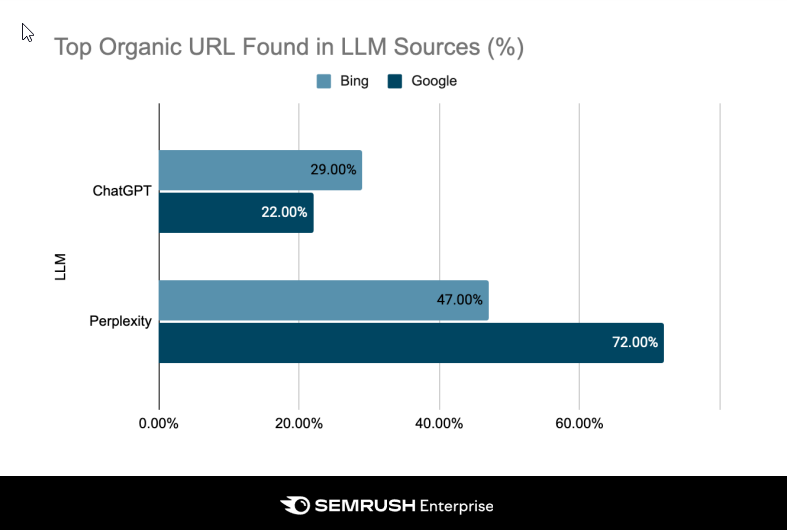
- 72% of Perplexity results include Google’s top-ranked page.
- Perplexity AI link card is 46% similar to Google’s top 10 organic rankings and 32% to Bing.
- ChatGPT-4 overlaps 48% with Google and 69% with Bing’s top 10.
This study shows a strong correlation between high Google rankings and visibility in AI search results.
Businesses that establish credibility and optimize for AI-driven search will continue seeing strong results.
SEO Delivers the Best Long-Term ROI—But Only If You Play the Long Game
SEO isn’t working anymore. ‘It’s dying”.
But wait…
Why would 70% of marketers say that SEO generates more sales for them than PPC?
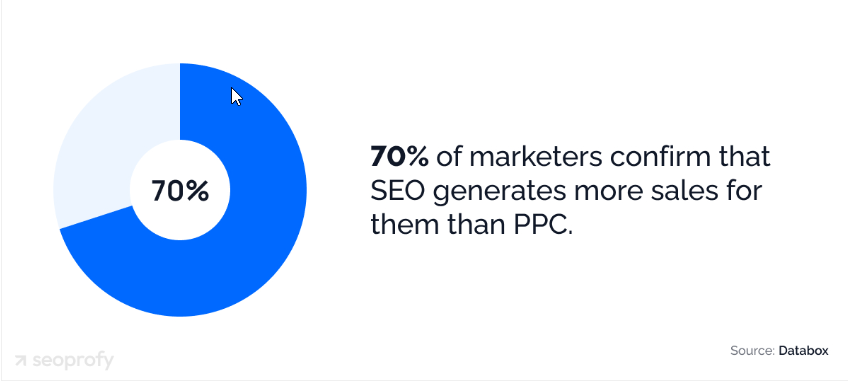
Don’t get it wrong.
It’s undeniable that paid searches are great for quick wins.
What those marketers mean is that SEO delivers better ROI than PPC in the long run.
You’ll eventually get stuck in an expensive cycle if your business relies entirely on ads for leads and customers.
Look at it this way;
You’ve just launched a new online business.
You’re excited, you start running Google and Facebook ads, and within days, visitors flood in.
Sales trickle through. Now you think, yes, this is it!
Then, you check your ad spend. You’ve burned through $2,000 in just two weeks.
You decide to turn off the ads only to realize that if you do that, traffic disappears.
How will new customers find you? You must keep spending just to maintain visibility.
That’s the problem with paid advertising.
It’s like renting a house. The minute you stop paying, you lose everything.
SEO, on the other hand, is buying the house.
It’s an upfront investment, but once you own it, the benefits keep coming.
Yes, SEO Takes Time, But It’s Worth It
SEO marketing can feel like a frustrating waiting game.
You put in the effort, yet, the results seem painfully slow compared to running paid ads, where you see traffic instantly.
This leads many to abandon SEO too early, assuming it doesn’t work.
SEO rewards those who play the long game.
It’s an investment that compounds over time. You’ve got to be consistent at it.
According to FirstPageSpeed 2025 SEO ROI statistics, Businesses that persist with SEO often start seeing the snowball effect after 6 to 12 months.
After the first year, their organic traffic increased steadily, customer acquisition costs dropped, and leads flowed in continuously.
The study also reveals that the peak ROI of an SEO marketing campaign often comes in the second or third year.
The more you invest in SEO marketing, the more sustainable and cost-effective your traffic becomes over time.
Besides that, search engines prioritize websites that consistently provide fresh, relevant, and valuable content.
When you publish high-quality content pieces, you’re not only improving your search rankings, but you’re also planting authority in your niche.
Consequently, you’ll build trust and credibility with people and search engines.
SEO is More Cost-Effective Than Paid Ads—Here’s the Proof
Any business that depends on paid advertising puts itself at the mercy of rising ad costs.
That isn’t a cooked-up theory.
The average CPC for Google Ads has been increasing steadily year-over-year. It was up 13% YoY in 2024 compared to the 9% jump of the previous year.
The story is the same for other paid advertising channels.
If PPC is the only way you get new customers, you’ll keep spending more to stay in business.
SEO offers a more sustainable and cost-effective alternative. A well-executed SEO strategy can save you up to 60% on customer acquisition costs.
On top of that, SEO delivers better engagement. Research shows that organic search results get a far much greater share of SERP clicks than paid results.
In this clickthrough rates (CTR) for organic vs paid search study, FirstPageSage found that the #1 organic result gets 18x more clicks than the #1 paid result.
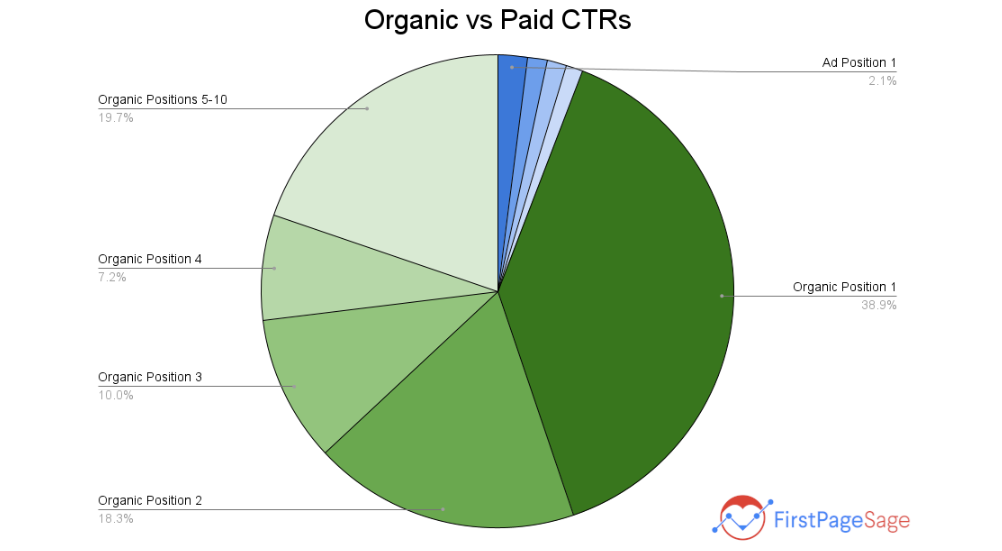
The report above is a true reflection of searchers’ behavior.
When was the last time you clicked any of the sponsored listings at the top of SERPs?
We all scroll right past them. And we’ve got our reasons for doing so.
To me, it’s a matter of trust and value.
Any business can pay their way to the top of SERP with ads.
For that reason, I trust ads less and I don’t see them answering my questions.
Organic results earned their positions and their content is most likely to match my intent.
Scott Zimmerman, Associate Director, Technical SEO at NP Digital posted the result of their SEO vs. PPC study on LinkedIn.
NP Digital compared 1000 SEO visitors vs 1000 PPC visitors and found that SEO delivers an 8x return compared to PPC’s 4x.
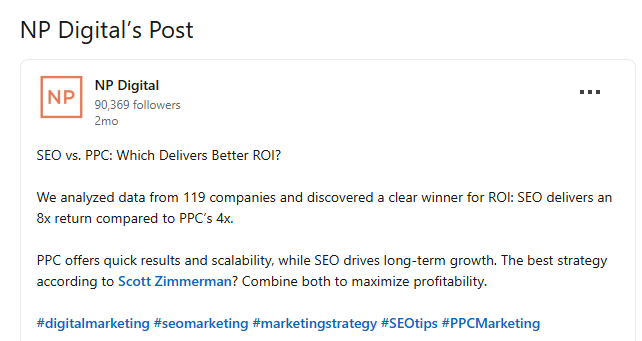
SEO vs. Social Media: Which One Drives More Business?
The allure of social media is undeniable.
We’ve seen influencers go viral overnight, gaining thousands of followers in hours.
One post, one reel, or even one tweet can explode in popularity, bringing massive attention to a brand.
This might lead you to consider focusing on social media instead of SEO.
But here’s the harsh reality…
Virality is unpredictable, and social media platforms, not you, control your reach.
The biggest challenge with social media is how fleeting its impact can be.
Platforms like Facebook and Instagram use algorithms that limit the number of followers who see your posts.
Organic reach on Facebook, for example, has plummeted to under 2% in 2024, down from the 16% in 2012.
Social Status, which tracks monthly reach benchmarks of social platforms, reported that Facebook’s organic reach in 2025 stands at 1.72%.
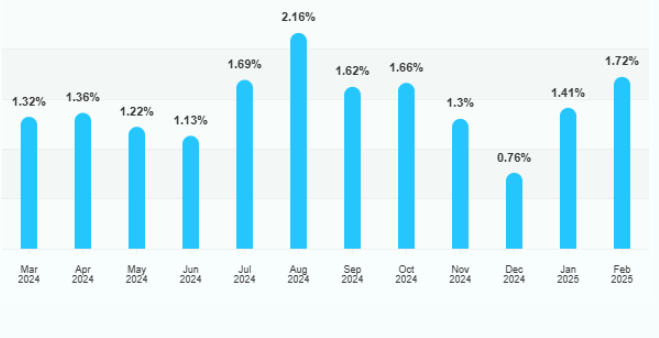
That means for every 1,000 followers, only 17 will organically see your content.
Even on Instagram where organic reach is slightly better than Facebook’s at 4%, it has declined by 18% year-over-year.
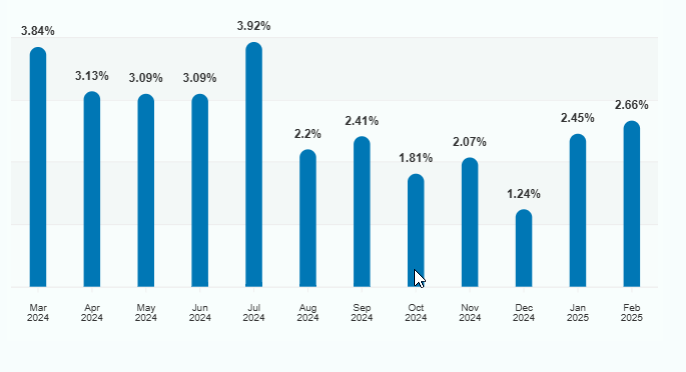
Platforms like TikTok and LinkedIn are also witnessing steady year-over-year declines. LinkedIn’s organic reach is now around 2.5% down to nearly half of 2024’s.
Unless you consistently pay for ads or get lucky with a viral post, maintaining visibility on social platforms is a war.
As if that’s not enough, social media posts often disappear within hours. You can’t rely on them for a steady flow of traffic.
In contrast, a well-written, optimized blog post or service page can continue bringing in traffic for months or even years.
That’s not to say social media has no role in marketing.
It can be great for brand awareness, engagement, and community building.
However, relying on it as your primary traffic driver is risky.
Algorithm changes, ad costs increase, and organic reach is limited.
Social media alone isn’t enough to build a sustainable business.
SEO, on the other hand, gives you an evergreen marketing asset.
Not All SEO is the Same: Small Business SEO vs. Local SEO
All businesses can benefit from SEO.
But the strategy that works for a national e-commerce brand won’t necessarily work for a local service provider like a chiropractor, dentist, or plumber.
Think about the last time you needed a plumber, dentist, or restaurant.
You probably searched “best [service] near me” and picked one from the local packs, right?
That’s local SEO in action.
You should focus on local SEO if you’re a local business with a physical location or serve customers in a specific geographic area.
Local SEO involves Google map rankings, local listings, and optimizing for location-based searches such as “best plumber in [your location]”.
That said, small businesses SEO works for all, whether you serve local or global customers.
It focuses on content marketing, backlinks, and broad keyword rankings to compete on a larger scale.
Why Small Businesses Struggle with SEO Marketing
As an SEO, I’ve had the privilege to audit quite several small business websites.
In most cases, after digging into these clients’ websites, I noticed almost instantly that SEO wasn’t failing many, they were failing at SEO.
Here are some far-too-common pitfalls I’ve seen plaguing dozens of small business websites.
1. No Content Strategy
SEO is marketing.
You need a solid strategy to make it work.
Businesses that fail to map out a clear content strategy end up shouting into the void.
In the case of one client, a chiropractic care consultant, she’s been blogging for four years.
Surprisingly, her website wasn’t getting any traffic.
You heard that right. Yes, zero organic traffic.
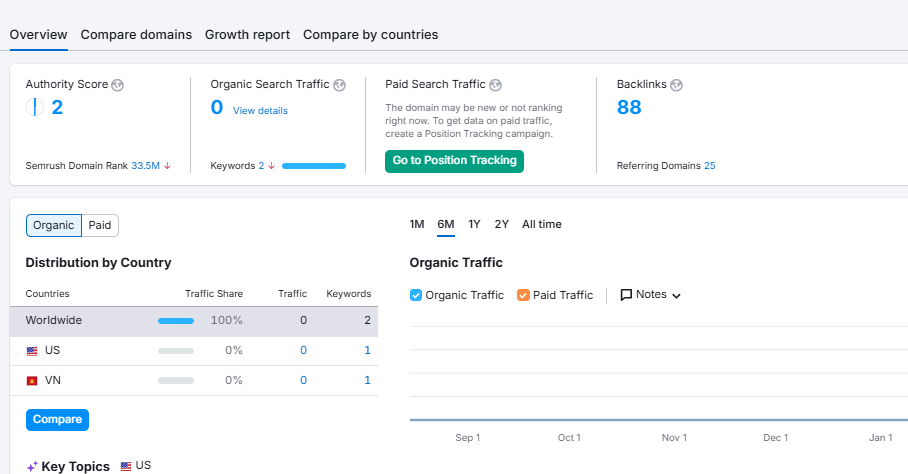
An audit wasn’t even needed to identify their problem.
Their content was all over the place when I looked at their blog, t
They write about topics like “How to Choose the Right Mattress” one week and “The History of Chiropractic Care” the next.
You could hardly spot the relationship between these contents.
But I wasn’t surprised since they had no content or SEO strategy.
The point I’m driving at is this…
Google doesn’t reward isolated random content.
The algorithm always favors websites with structured, strategic content that demonstrates expertise.
2. Abandoning Keyword Research
Some business owners pick content topics in their heads.
In their mind, that’s what people are searching for.
I’ve seen law firms publishing content on topics like “Understanding the Statute of Limitations for Civil Litigation.”
That’s some fancy legal jargon.
Except for a lawyer, I doubt anyone would type such a query into Google.
Clients seeking solutions to their problems don’t know such legal lingos exist.
They’d just pop on to Google and type in their own language.
Searches like…
“Can I sue my employer for wrongful termination?” and “How much does a personal injury lawyer cost?”
So for months, they were publishing for themselves, not their audience.
They wasted time and money creating content no one wanted to read.
3. Targeting Broad Keywords
As explained above, not chasing keywords is a problem.
But also, going after the wrong keywords is an even bigger problem.
Small businesses that chase broad, high-competition keywords will forever lose to industry giants.
A small boutique skincare brand trying to rank for “best moisturizer” has no chance.
That keyword is dominated by billion-dollar beauty and e-commerce brands such as Sephora, Ulta, Amazon, etc. with massive budgets and age-long reputations.
Besides the competition, another big problem with broad keywords is the lack of intent by searchers.
The broader a keyword is, the further away it is from conversion and the more difficult ranking becomes.
The chart below from Backlinko shows that.
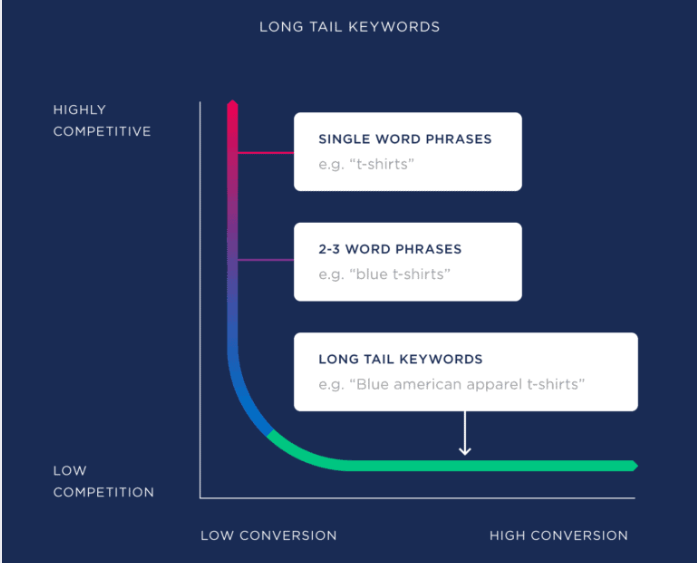
Nowadays, 70% of all searches are long-tail keywords.
Keywords like “best moisturizer for sensitive acne-prone skin” and “best fragrance-free moisturizer for eczema” have a stronger buyer intent.
These keywords are easier to rank for.
They are hyper-specific and match potential customers’ search phrases.
4. Low-Quality Content
More than ever before, Google is ruthless about content quality.
The March 2024 core update aimed at removing at least 40% of low-quality, unoriginal content in search results.
And to many, Google went overboard with it.
Even big brands’ websites were massively hit, with some removed and deindexed completely.
According to Google, low quality comes in many forms:
- Overly promotional content: Blog posts that read like sales pitches instead of helpful, informative content. I think that’s why affiliate websites are the most widely impacted by the update.
- Spammy AI-generated content: Churning out AI-written blog posts that lack depth, originality, or personal expertise. Here’s where Google stands on AI content.
- Thin content: Pages with only 200–300 words that barely scratch the surface of a topic. These don’t satisfy search intent and are unlikely to rank well.
- Keyword-stuffed content: Content that forces keywords unnaturally, making them unreadable. This outdated tactic used to work but now triggers Google penalties.
- Outdated or Inaccurate Content: Google demotes pages with outdated or factually incorrect information, especially if they are in the YMYL niches.
- Content that lacks expertise: Google wants content written by people with real-world knowledge. A financial planning article written by someone with zero industry experience won’t rank against content from an actual financial expert.
- Duplicate or plagiarized content: Copying content from other sources without adding unique value is an SEO disaster. Google recognizes and penalizes duplicate content.
Google’s algorithm favors helpful, reliable, people-first content that isn’t created to gain search engine rankings but to help people.
So, if your content isn’t helpful, it won’t rank.
Using Google’s EEAT signals is a simple way to evaluate the quality of your content (I’ll show you how later).
5. Ignoring Technical SEO
SEO is beyond what’s on the page.
Unfortunately, many small businesses aren’t concerned about how well their websites function.
A slow, clunky, or broken website will sabotage even the best SEO marketing effort.
You must ensure your website is crawlable, indexable, and optimized for users and search engines.
Here are critical areas to look into to get your technical SEO on point:
Site Speed
If your site takes too much time to load, Google will trust it less and consequently send less traffic to you.
Search engines won’t waste resources on a slow-loading site when millions of others with lightning-fast speed serve the same content.
According to Google, “The probability of bounce increases 32% as page load time goes from 1 second to 3 seconds.”

Also, pages that load within 2 seconds have an average bounce rate of 9%, while pages that take 5 seconds to load see bounce rates jump to 38%.
How to Improve: Use tools like Google PageSpeed Insights to identify performance issues. Compress images, enable browser caching, and consider upgrading your hosting plan.
Mobile-Friendliness
Having a mobile-friendly site is more important than ever before.
53% of users abandon your website If it takes more than 3 seconds to load.
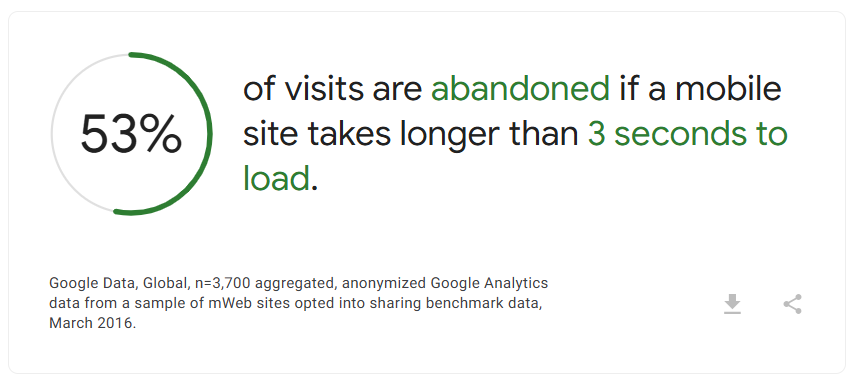
Moreover, Google uses mobile-first indexing, meaning it primarily uses the mobile version of your site for ranking and indexing.
With 63% of all website traffic now from mobile devices, the mobile version of your site is as important as the desktop version, if not more.
How to Improve: Use responsive design, ensure buttons and links are easy to tap, and test your site using Google’s tMobile-Friendly Test.
HTTPS for Site Security
Implementing HTTPS on your website safeguards user data and positively impacts search engine rankings.
Google has been prioritizing secure websites since 2014, and HTTPS is now a ranking signal.
Secure connections (HTTPS) are essential for building trust with visitors. According to HubSpot research, 82% of users will leave a site if it’s not secure.
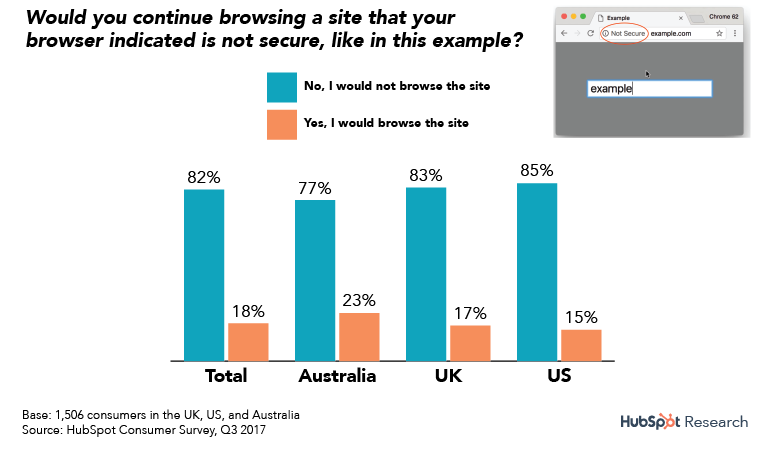
How to Improve: Migrate your site to HTTPS by purchasing an SSL certificate and updating links to the secure version.
Fixing Broken Links
Broken links and crawl errors can harm your site’s usability and rankings.
When Ahrefs analyzed the link profile of over 2 million domains, it found that 66% of websites have at least one broken link, and these errors can lead to a poor user experience. It also affects the crawlability of a site.
How to Improve: Use tools like Screaming Frog or Google Search Console to identify and fix broken links, redirect errors, and orphan pages.
6. Ignoring Local SEO
If your business serves local customers, local SEO is your best shot at growing it.
In fact, your Google Business Profile is more important than your website for attracting customers.
Optimizing for local search will skyrocket your inbound calls and foot traffic.
Don’t take my word for it.
- 76% of people who search for a local business visit within 24 hours (Google).
98% of consumers used the Internet to find information about local businesses (BrightLocal) - 88% of users who perform local searches on mobile phones visit related stores within a week (Google)
- 80% of US consumers search for a local business weekly (SOCi)
- Businesses that appear in Google’s local “3-pack” receive 126% more traffic than businesses ranked 4-10. (SOCi)
Now, imagine your business isn’t showing up in local search results. That’s a lot of missed opportunities every single day.
Here are a few tips to get local SEO right
- Optimize your GMB profile: Claim and optimize your Google business profile. Fill out every your profile, including business hours, photos, and services.
- Get multiple local citations and ensure NAP consistency: Listing your business name, address, and phone number (NAP) on multiple local citations helps search engines verify your legitimacy. Use platforms like Yelp, Yellow Pages, and industry-specific directories. Ensure your NAP information is consistent everywhere.
- Target Location-Specific Keywords: Targeting location-specific keywords is crucial for local SEO. If you’re a roofing company in Dallas, you should optimize your website “roof repair in Dallas”. Use tools like Google Keyword Planner or Ubersuggest to find local keywords with high search volume and low competition.
- Get customer reviews: Reviews are a major ranking factor for local SEO. 75% of consumers check online reviews before engaging a local business (Brightlocal)
- Publish localized content: Publish blog posts, videos, or guides that address local topics, events, or trends. Creating content tailored to your local audience can boost your rankings and engagement. For example, a real estate agent in Miami could write a blog post titled “Top 5 Neighborhoods to Buy a Home in Miami.”
7. No Link Building Strategy
Building links is one of Google’s confirmed ranking factors. Yet, many small businesses overlook it.
Links are votes of confidence for your website.
When other reputable sites link to your content, it signals to search engines that your site is authoritative and trustworthy.
That’s why websites with more backlinks rank higher in search results.
So how do you build backlinks?
- Create link-worthy content: High-quality, original content naturally attracts backlinks.
- Guest blogging: Writing guest posts for reputable websites in your industry is a great way to earn backlinks.
- Leverage broken links: Use tools like Ahrefs or Check My Links to find broken links on other websites and suggest your content as a replacement.
Similarly, internal links help search engines understand the structure of your site.
Without them, search engines may have difficulty finding and indexing your pages.
Another benefit of Internal links is that they guide users to related content on your site. Thereby, increasing dwell time and reducing bounce rates.
8. Not Tracking Performance
I once asked a business owner what their top-performing blog post was.
Surprisingly, they had no idea because they weren’t tracking anything.
That’s a common trait in small business owners, especially solopreneurs.
Tracking your SEO performance allows you to measure the effectiveness of your efforts and make data-driven decisions.
Without it, you’re left guessing which strategies are driving results and which are wasting resources.
Google Analytics and Google Search Console are two free powerful tools that offer valuable insight into website performance.
You may want to ask…
What are the key metrics to track?
- Organic traffic: How many visitors get to your site from searches?
- Keyword Rankings: How well does your site rank for targeted search phrases?
- Click-through rate (CTR): How often users click on your site in search results. A low CTR could indicate that your title tags or meta descriptions need improvement.
- Bounce rate: The percentage of visitors who leave your site after viewing only one page. A high bounce rate could indicate poor content or user experience.
- Conversion rate: How many visitors take a desired action, such as purchasing or filling out a contact form.
Besides Google’s free tools, paid SEO software like Ahrefs, SEMrush, and Moz offer in-depth competitor analysis, backlink tracking, and keyword insights.
Use E-E-A-T to Improve Your SEO Marketing
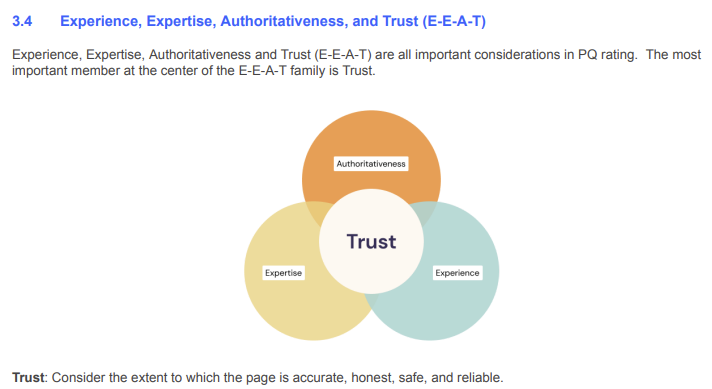
Google’s EEAT (Expertise, Experience, Authoritativeness, and Trustworthiness) is the gold standard for measuring content quality.
If your content aligns with these signals, it has a much better chance of ranking.
Here’s how to evaluate your content using EEAT:
Experience – Do you have first-hand knowledge?
Your content should reflect real-world experience, whether it’s through personal stories, case studies, or practical examples.
Use phrases like “In my experience…” or “From working with clients, I’ve found…” to show that your insights come from real-life practice.
Expertise – Are you a subject matter expert?
Your content should reflect a deep understanding of the subject, backed by data, research, or credentials. Cite reputable sources to back up claims (government sites, academic studies, industry leaders).
Use author bios to highlight expertise. If you have relevant qualifications, mention them in your author bio.
Authoritativeness – Are you a recognized source?
Your content needs to demonstrate authority in its niche. The more Google sees your site as a go-to resource, the better your rankings.
Google wants to see that other reputable sites and users view your content as authoritative.
Create content that people would love to share. Include statistics, quotes from experts, or links to authoritative sources. Try to get backlinks from reputable and niche-relevant sites.
Trustworthiness – Is your information reliable and well-sourced?
Your content should be factually correct, up-to-date, and free from errors. Regularly update old content, fix broken links, and ensure your site has a privacy policy and contact information.
Better SEO Marketing for Your Small Business
Now you have your answer and I bet that’s “YES, SEO is worth it for small businesses”.
But like any investment, its value depends on how you approach it.
To win big with SEO, you must have a long-play mindset and be dedicated to creating a better experience for your website visitors.
And I get it. SEO can be overwhelming, especially when juggling it with the day-to-day demands of running your small business.
At HubCopy, we help small businesses with end-to-end SEO content services.
Ready to grow your small business with SEO marketing? Let’s make it happen.


